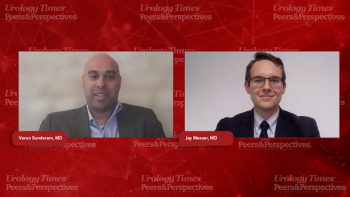
Optimizing NMIBC Treatment Through Sequencing and Patient Preference
Panelists discuss the complexities of treatment selection and sequencing in non–muscle-invasive bladder cancer (NMIBC) amid pending trial data, emphasizing the potential of emerging chemotherapy backbones, biomarker-driven personalization, and patient-centered decision-making to balance efficacy, quality of life, and evolving bladder-preserving options.
Episodes in this series

Treatment selection and sequencing in non–muscle-invasive bladder cancer remains a complex and evolving challenge. Currently, there is still a lot of uncertainty about the best approaches, partly because key clinical trial data are still pending. Trials like the BRIDGE study, which compares chemotherapy-based regimens to traditional BCG, are expected to shed light on whether new backbones of therapy might emerge. Although the BRIDGE trial uses a noninferiority design—meaning it aims to show that new therapies are at least as good as BCG rather than definitively better—a strong positive signal could pave the way for future combination trials that integrate chemotherapy with novel immunotherapies. Meanwhile, advances in technology, such as AI-driven histopathology and biomarker signatures, are becoming critical tools to predict which patients will respond best to specific treatments, aiming for more personalized therapy.
Patient-centered care plays a vital role in guiding treatment decisions today. Clinicians typically start by discussing all available options in detail, especially in challenging scenarios such as BCG-unresponsive disease. The traditional recommendation often begins with radical cystectomy, which offers the best chance for cure but comes with significant risks, including impacts on urinary and sexual function and a small but real risk of perioperative mortality. Many patients understandably seek bladder-preserving alternatives, which historically have been limited. However, recent approvals and ongoing trials of agents like checkpoint inhibitors, novel intravesical therapies, and gene therapy offer new hope. These options require thorough patient education about the benefits and potential adverse effects, with many patients opting to enroll in clinical trials to access cutting-edge treatments while contributing to the evidence base.
Ultimately, tolerability and preserving quality of life remain key considerations, especially as treatment landscapes become more complex with multiple available lines of therapy. The hope is that as more data emerges and biomarkers are refined, physicians will be able to more precisely tailor treatment sequencing to individual tumor biology and patient preferences. Until then, clinical judgment combined with transparent patient discussions and trial participation remains the best strategy for navigating this “black box” of treatment choices.
Newsletter
Stay current with the latest urology news and practice-changing insights — sign up now for the essential updates every urologist needs.


















